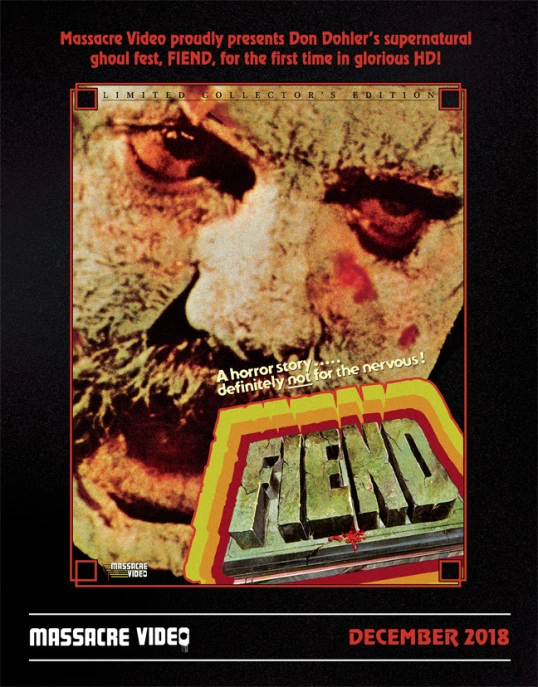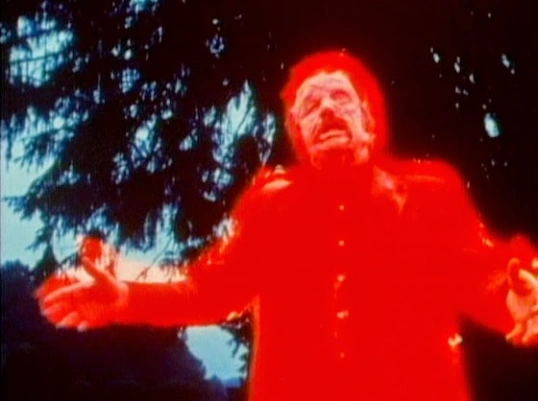Fiend (reviewed by Lisa Marie Bowman)
The 1980 film, Fiend, is a movie that should be viewed by every aspiring indie filmmaker. I’m going to tell you why in a few paragraphs but first, allow me to tell you what Fiend is.
Fiend opens with ominous music and a shot of a seemingly deserted cemetery. While the camera tracks it’s way from headstone to headstone, we become aware of a red light that seems to be floating above the ground, as if it’s searching for something. The light suddenly plunges into a grave. A few seconds later, the man who was in the grave claws his way to the surface. Just one look at him reveals that he’s been dead for quite some time. However, you might be distracted from the facial decay by the fact that the man is glowing.
The man staggers about, eventually coming across a young woman who has been abandoned in the cemetery by her jerk of a boyfriend. The man grabs her from behind and wraps his hands around her neck. Briefly, the man’s glow seems to pulse and then it fades away. The man is no longer a decaying corpse. Now, he’s just a middle-aged guy with a huge mustache. He looks like he should be teaching a remedial math class.
(Perhaps not coincidentally, Don Leifert, the actor playing our living corpse, actually was a teacher.)
Now calling himself Eric Longfellow, the man moves into a nice house in the suburbs and establishes himself as a music instructor. Longfellow tends to keep to himself, which certainly makes the neighbors a bit curious about him. Longfellow would probably be more sociable if not for the fact that, every few days or so, he starts to decay. For that reason, he has to have a constant supply of victims so that he can suck out their life force and renew himself. Helping him out with this issue is Dennis Frye (played by George Stover, who was apparently a civil servant when he wasn’t acting), who is kind of squirmy and owns some of the ugliest suits ever tailored. (I assume that Dennis Frye’s name is an homage to Dwight Frye, who played Renfield in Dracula.)
Now, of course, you can only suck the life force out of so many people before people start to notice that something strange is going on. Longfellow is unfortunate enough to live next door to Gary Kender (Richard Nelson), who is a plain-spoken, beer-drinking guy who just happens to have a mustache that’s almost as huge as Longfellow’s. Gary doesn’t trust Longfellow so he starts to do some research on his mysterious new neighbor….
Now, here’s the thing to remember about Fiend. It was made foe $6,000. That would translate to about $18,000 today. Either way, it’s a tiny budget. And yet, it’s an effective (if occasionally goofy) little film and, more often that not, it’s effective precisely because it was shot for next to nothing. The grainy images give the film a feeling of immediacy. Though the majority of the murders may have happened in broad daylight because day is easier to light than night, all those daytime murders contribute to the sense of unease, the feeling that no one’s safe at any time. Even the amateur quality of the performances contribute to the film’s overall dream-like feel. Director Don Dohler may not have been able to afford expensive special effects or realistic gore but, as a result of that, his direction emphasizes atmosphere over jump scares. I mean, don’t get me wrong. This is definitely an amateur film, full of clunky dialogue and the occasional slow scene. But so what? Even those flaws add to the film’s nicely surreal atmosphere.
I mean, consider this. Don Dohler made this film nearly 40 years ago and he spent less money on the entire production than most films spend during one day of shooting. It was released in only a handful of theaters and I imagine it probably didn’t get rave reviews from the mainstream critics. And yet, here we are, decades later, and Fiend still has a growing cult of admirers. When I watched the film on YouTube, I read several of the positive comments left underneath it. Several of them are from people who either worked on the film or who knew Don Dohler and Don Leifert. For the most part, everyone seems to have fond memories of both this film and the filmmakers.
Fiend works because, instead of surrendering to the film’s low budget, Don Dohler used it to his advantage. There’s a lesson there for us all.


